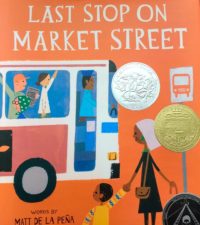Last Stop on Market Street

Last week I read and discussed Matt de la Peña’s award winning picture book Last Stop on Market Street.
Here’s the lesson I used–Last Stop on Market Street. 
I opened to the first page and asked how the neighborhood in the book looked different from the suburban neighborhood we were in. The kids were pretty quiet; they noted the city bus but no one mentioned the diverse characters.
Then, a 5-year-old raised her hand and said, “It doesn’t look like here. It looks like the place with my daddy’s tall work building.” That led to a discussion about homes in urban and suburban areas. The kids noted the two aren’t far apart geographically but are different.
I often give the kids something to find the answer to while they listen to a story. Today’s question, “Why do you think the author, Matt de la Peña said in an interview that he specifically wanted suburban kids to read this book?”
The kids’ nods didn’t surprise me; they were very much engaged as I read, showing why this book demonstrates “an appreciation for African American culture and universal human values.”
 This book was nominated for the Coretta Scott King Award for exactly that reason. The kids talked about the races of the characters and the strong relationship between the main character and his grandmother.
This book was nominated for the Coretta Scott King Award for exactly that reason. The kids talked about the races of the characters and the strong relationship between the main character and his grandmother.
I started wondering how often kids talk about diversity after reading children’s books. And I did some research.
Only 13% of children’s books published in the last 25 years contain multicultural content, yet nearly 40% of students are children of color. Not only is it important for children of color to read books about people who look like them, but it’s very important for white kids to read about kids who are different from them!
In 2014, the NY Times op-ed “Where Are the People of Color in Children’s Books?” brought attention to the problem. Change is slow but some progress is being made. Last year 31% of children’s books contained multicultural content, but only 7% were written by Black, Latino, or Native authors.
Even though the setting of the story is different from their own neighborhood, the kids connected to the characters, especially their service at a soup kitchen. They told inspiring stories of relationship and service. We finished our lesson by reflecting on the grandmother’s wise words, “Sometimes when you’re surrounded by dirt, CJ, you’re a better witness for what is beautiful.”
Next time I visit, we’ll roam around and photograph things of beauty in unexpected places–cleaning supplies in the custodian’s closet, books on the shelves, big kids helping younger kids, friends playing together.
